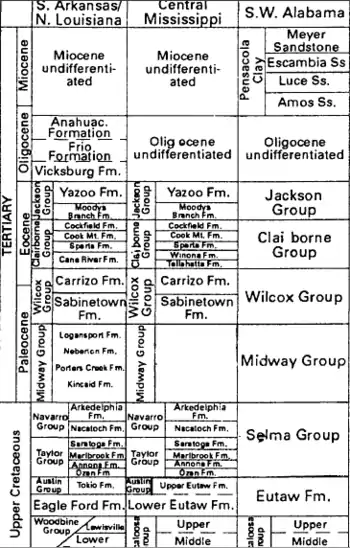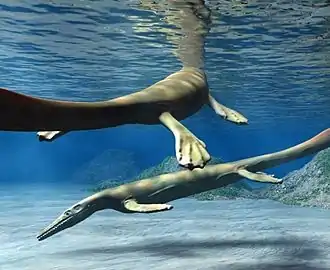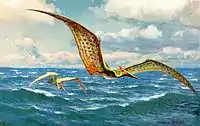Eutaw Formation
The Eutaw Formation is a geological formation in North America, within the U.S. states of Alabama, Georgia, and Mississippi. The strata date from the late Coniacian to the early Santonian stage of the Late Cretaceous.[1] It consists of the upper Tombigbee Sand Member and an unnamed lower member. Dinosaur, mosasaur, and pterosaur remains have been recovered from the Eutaw Formation.[2][3]
| Eutaw Formation Stratigraphic range: Upper Cretaceous | |
|---|---|
| Type | Geological formation |
| Sub-units | Tombigbee Sand Member, Ingersoll Shale |
| Underlies | Austin Group and Mooreville Chalk Formation |
| Overlies | Tuscaloosa Group |
| Thickness | 40 m (130 ft) to 120 m (390 ft) |
| Lithology | |
| Primary | Glauconitic sandstone |
| Location | |
| Region | Alabama, Georgia, Mississippi |
| Country | United States |
| Type section | |
| Named for | Eutaw, Alabama |

Stratigraphic column for the Eutaw
Vertebrate paleofauna
Mosasaurs
| Mosasaurs of the Eutaw Formation | ||||||
|---|---|---|---|---|---|---|
| Taxa | Species | State | Stratigraphic position | Abundance | Notes | Images |
|
Clidastes sp.[2] |
 Eonatator sternbergii  Platecarpus tympaniticus | |||||
| ||||||
|
P. tympaniticus[2] |
||||||
|
S. russelli[2] |
||||||
|
Tylosaurus sp.[2] |
||||||
Ornithodires
Dinosaur feathers have been found in the Ingersoll Shale of Georgia, which is a subunit of the Eutaw Formation.[3] Indeterminate hadrosaurid remains have been found in Mississippi.[5]
| Ornithodires of the Eutaw Formation | ||||||
|---|---|---|---|---|---|---|
| Genus | Species | State | Stratigraphic position | Abundance | Notes | Images |
|
Indeterminate |
 Pteranodon sp. | |||||
See also
References
- Liu, Kaiyu. "Facies Changes of the Eutaw Formation (Coniacian-Santonian), Onshore to Offshore, Northeastern Gulf of Mexico Area". Department of Geological Sciences. University of Alabama. Retrieved 2009-02-10.
- Kiernan, Caitlin R. (2002). "Stratigraphic distribution and habitat segregation of mosasaurs in the Upper Cretaceous of western and central Alabama, with an historical review of Alabama mosasaur discoveries". Journal of Vertebrate Paleontology. 22 (1): 91–103. doi:10.1671/0272-4634(2002)022[0091:SDAHSO]2.0.CO;2.
- "Coastal Plain Geologic Province". The New Georgia Encyclopedia. Georgia Humanities Council and the University of Georgia Press. 2007-08-30. Retrieved 2009-02-10.
- Bardet N, Suberbiola P, Iarochene M, Bouyahyaoui F, Bouya B, Amaghzaz M (2002). "A new species of Halisaurus from the Late Cretaceous phosphates of Morocco, and the phylogenetical relationships of the Halisaurinae (Squamata: Mosasauridae)". Zoological Journal of the Linnean Society. 143 (3): 447–472. doi:10.1111/j.1096-3642.2005.00152.x.
- Kaye, John M.; Russell, Dale A. (January 1973). "The Oldest Record of Hadrosaurian Dinosaurs in North America". Journal of Paleontology. 47 (1): 91–93. JSTOR 1302869.
This article is issued from Wikipedia. The text is licensed under Creative Commons - Attribution - Sharealike. Additional terms may apply for the media files.